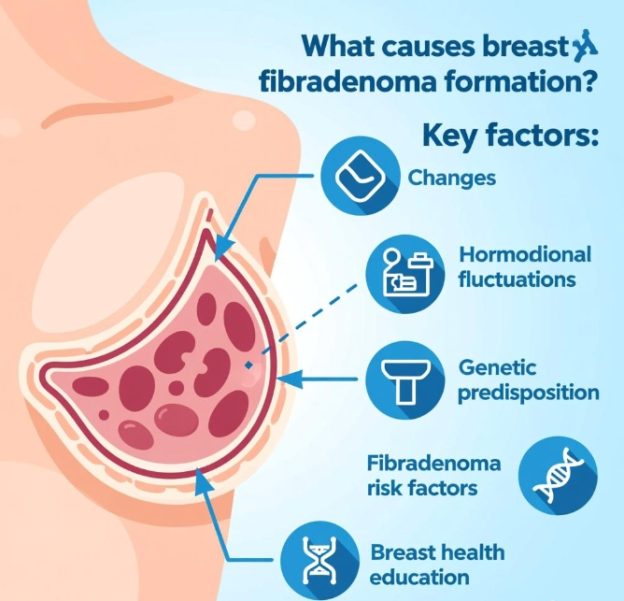Breast fibroadenoma is a benign biphasic tumour composed of proliferating glandular and stromal elements. It is the commonest solid breast mass in women under 30 years and is strongly hormone-responsive. Most lesions are solitary and indolent, but multiple or rapidly enlarging variants require exclusion of phyllodes tumour or carcinoma.
- Painless, highly mobile nodule
Typically 1–3 cm, firm, smooth, and well-circumscribed; the “slip sign”—easy displacement under the fingers—distinguishes it from malignant masses that adhere to surrounding tissue. - Smooth, regular margins
Palpation reveals an ovoid or gently lobulated contour with a distinct edge; deep lesions may feel discoid when compressed against the chest wall. - Hormonal modulation
Size and tenderness often increase during the luteal phase, pregnancy, or hormone-replacement therapy; spontaneous regression is common after menopause. - Multiple or bilateral occurrence
Up to 20 % of patients harbour two or more synchronously detectable masses; metachronous contralateral appearance supports a field effect rather than de-novo malignancy. - Giant fibroadenoma (> 5 cm)
Rapid enlargement can cause visible breast asymmetry, skin venous prominence, and rarely nipple deviation; core biopsy is mandatory to exclude juvenile phyllodes tumour. - Absence of skin or nipple changes
Erosion, retraction, peau d’orange, or spontaneous discharge are not features of classic fibroadenoma; their presence mandates malignancy work-up. - Stability or slow growth
Most lesions remain static for months to years; any new irregularity, fixation, or accelerated increase in size warrants imaging-guided core biopsy. - Imaging characteristics
Ultrasound: hypoechoic, oval mass with gentle posterior enhancement and no internal vascularity on Doppler. Mammography: circumscribed, dense nodule with occasional coarse “pop-corn” calcifications in involuting lesions.
| Symptom / Sign | Typical Presentation |
|---|---|
| Painless mass | 1–3 cm, firm, highly mobile, well-circumscribed |
| Regular margins | Smooth, ovoid or gently lobulated |
| Hormonal change | Enlarges during luteal phase/pregnancy, regresses post-menopause |
| Multiple lesions | 20 % synchronous, bilateral possible |
| Giant variant | > 5 cm, asymmetry, venous pattern, needs biopsy |
| Skin/nipple | No erosion, retraction, or discharge |
| Growth pattern | Stable; sudden change → biopsy |
| Imaging | Hypoechoic oval on US, circumscribed on MG |
